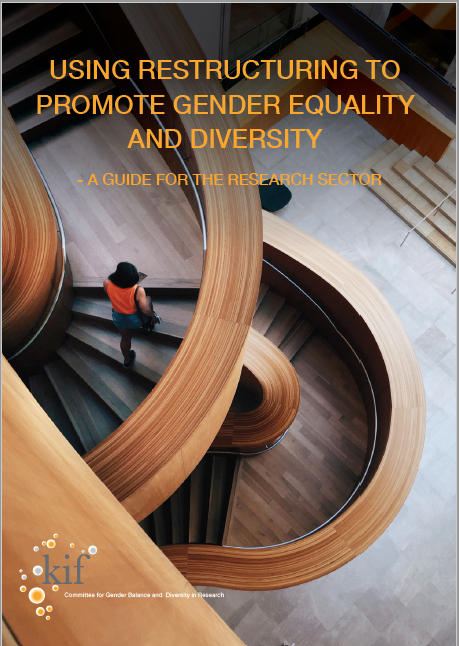KIF Committee’s recommendations for gender balance
Under the Equality and Anti-Discrimination Act, all universities, university colleges and research institutes are required to conduct active, targeted and systematic efforts to promote equality and prevent discrimination. Reports that account for these efforts are to be drawn up annually.
Universities, university colleges and research institutes are also expected to address the major societal challenges targeted in the UN Sustainable Development Goals, which make specific mention of gender equality and inequality. The EU Gender Equality Strategy and Norway’s European Research Area (ERA) Roadmap also identify specific objectives for gender balance and gender perspectives in research that Norwegian academia are required to pursue.
Promoting gender balance in higher education institutions and research institutes is an ongoing effort with a long-term perspective. Over time, this work has yielded a wide array of knowledge and experience in both a Norwegian and an international context. The Committee for Gender Balance and Diversity in Research (KIF Committee) knows that certain factors are essential to enable gender balance efforts to achieve the desired results, not only for individual academic staff members but for the many institutions in the sector. Efforts to advance gender balance objectives require institutions to change both their culture and their structure.
Based on all the knowledge accumulated in research findings and practical guides, and the insight and experience of the committee members themselves, the KIF Committee has drawn up a set of recommendations to support gender balance efforts at all levels of universities, university colleges and research institutes. We wish to address these recommendations to the management of all the relevant institutions in Norway. Managers are essential to the success of efforts to achieve gender balance.
The recommendations are further intended for those of you who work every day to promote gender balance and ethnic diversity in Norwegian higher education and research.
The recommendations are also applicable to efforts to promote ethnic diversity. It is constructive to carry out activities relating to gender and diversity in parallel, for example by encouraging institutions to incorporate gender balance considerations when recruiting internationally and ensuring that gender balance measures include women with minority backgrounds.
The KIF Committee recommends the following:
- Make sure that the managers are on board – that they assume formal responsibility for the work and give it sufficient priority.
Managers hold the key – and are the key – to making gender equality a priority within the organization. Management that is accountable for and oriented towards gender equality is essential to create lasting structural and cultural change. - Create a strong framework to support the efforts and a plan for assigning responsibility and monitoring progress.
A framework tailored to the organization and closely tied to the management is vital to the success of gender balance efforts. Many institutions choose to set up a committee with direct support and/or involvement from the management. In addition, someone should be assigned specific responsibility for ensuring progress and long-term follow-through. - Set aside enough resources – for both staff positions and measures.
Promoting gender balance and diversity is full-time work. In order to achieve results, institutions must dedicate adequate personnel resources and set aside funds for implementation of measures. This work requires expertise, time and follow-up over time. - Set short-term as well as long-term goals.
The goals must address the challenges identified at the given institution and must be realistic. Having both long-term and short-term goals makes it easier to achieve results that can inspire efforts in the longer term. - Know your own organization:
- Conduct an organizational analysis and collect gender-specific statistics.
- Learn about cultural and structural factors that pose obstacles to gender balance.
The better you know your own institution, the easier it is to identify appropriate goals and the measures needed to achieve them. This means taking the time to do the preparatory work of collecting both qualitative and quantitative information about your institution. This information will help in identifying appropriate measures and tracking the development of efforts over time. This can be done through interviews, document analysis and analysis of gender-specific statistics at the institution. - Find measures that address your institution’s identified challenges.
There are a number of measures to be found at the institutional and personnel levels. At the personnel level there are both individual measures of limited duration and long-term structural measures. For an overview of measures, see Gender balance measures. - Formalize recruitment procedures to minimize bias and subjective assessment.
Research on recruitment processes at institutions indicates that formal, transparent routines with well-defined criteria regarding competency requirements and their weighting leave less room for implicit bias. Such routines can also help to prevent decisions based on subjective assement and unconscious prejudices. - Be flexible and test out new approaches.
Finding the right measures to bring about change may involve some trial and error. Promoting gender balance is a constant learning process. When planning and implementing the way forward, time must be set aside to evaluate efforts along the way. - Build competency in gender balance and diversity at your institution – hold regular courses for managers and HR advisors.
It is important that gender equality efforts are not dependent on specific individuals in the organization, but instead are supported by management at the institution’s department, faculty and top administrative levels. It is therefore vital to incorporate gender equality and gender balance issues into management training at research institutions. This boosts awareness and knowledge of the topic, and managers learn how to lead the way towards better gender balance and diversity at their institution. - Gender balance efforts need to be reflected in the research (gender dimension), curriculum content and events as well as in who teaches at the institution.
Academia encompasses knowledge-producing institutions with a wide variety of tasks. It is important that efforts to promote gender balance are not isolated within a few areas of an institution’s activities but are reflected in all its activities. - Keep a long-term perspective.
Promoting gender equality and gender balance is an ongoing effort. Achieving the intended results can take time, and there may be periods when results fail to materialize. This needs to be taken into consideration when planning activities and budgeting. - Be prepared for resistance, and identify strategies to address it.
Gender balance and diversity efforts mean challenging norms, conduct and routines – an institution’s very structure and culture. This is a change process that will be experienced in different ways, and there will always be those who resist. It is important to be prepared for this, in order to address any resistance constructively and without impeding or harming the institution’s gender balance efforts.
See also: Why work to improve the gender balance and increase diversity in research?
Literature used for the KIF Committee's recommendations
The recommendations are based on extensive literature. In particular, the following resources have formed the basis of the committee’s recommendations:
- Casaca, S. F. & Lortie, J. (2017). Handbook on Gender and Organizational Change. International Training Centre of the International Labor Organisation (ILO).
- European Institute for Gender Equality (EIGE) (2016):
- Integrating gender equality into academia and research organizations: Analytical paper.
- Gender Equality in academia and research – GEAR tool.
- Roadmap to Gender Equality Plans in research and higher education institutions: a short guide / Success factors and common obstacles. - Female Empowerment in Science and Technology Academia (FESTA). Handbook on resistance to gender equality in academia.
- Frølich, Nicoline et al. (2019). Attraktive akademiske karrierer? Søkning, rekruttering og mobilitet i UH-sektoren. NIFU-rapport 2019:10.
- Orupabo, J. & Mangset, M. Promoting Diversity but Striving for Excellence: Opening the ‘Black Box’ of Academic Hiring. (DRAFT)
- Science Europe (2017). Practical guide to improving gender equality in research organizations.
- Sørensen, S. Ø. et al., Senter for tverrfaglige kulturstudier, NTNU (2018). «Verktøykasse» for bedre kjønnsbalanse. Håndbok med tiltak for institutter som vil bedre kjønnsbalansen blant vitenskapelig ansatte. Rapport 3/2018 fra «Likestilling nedenfra».
- Swedish Secretariat for Gender Research (2016). Guidelines for Gender Mainstreaming Academia. Gender equality in academia 2016:1.
Guide for gender equality and diversity

